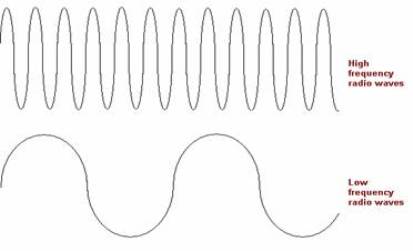
*20mssbcwdipolesimplexPEP???*
The communications arm of preparedness is an important one, but can be one that is easy to push to the side. Itís not particularly glamorous and can be somewhat intimidating to the uninitiated. When I decided it was time to get serious about communications, I started reading all the articles I could find about ham radio, beginner & beyond. What I discovered was that I needed a preschool primer to amateur radio. I wanted, and needed, VERY basic information.
This purpose of this article is to help give basic, simplified information to someone who is as uniformed as I was when I started. They can then use this as a base to learn more.
First, basic radio wave information:
A radio wave is an invisible energy wave. A radio transmitter makes a basic wave (with the help of electricity and other components), and then changes the wave to add information to it. The wave is then sent from the transmitter to its antenna. The antenna radiates that wave into the surrounding environment. At the other end, the antenna of a receiver picks up the signal wave, and the receiver converts the radio wave into an audible sound and amplifies (increases) it.
The distance that the wave travels depends, among other things, on the characteristics of the wave itself, the power with which it was transmitted, the direction the antenna is pointed, the type of antenna, and environmental/physical barriers.
The physical characteristics of a wave:
There are two main descriptive terms people use when talking about waves: their frequency and their wavelength. The frequency of a radio wave is the number of back and forth cycles of the wave that are produced per second. This is measured in hertz. The more waves there are in a second, the faster they are resonating, the higher the frequency.
The wavelength of a wave is the physical length of the wave. Wavelength has an inverse relationship to frequency. The higher the frequency, the lower the wavelength (if the wave is resonating very quickly the length from one peak to the next--wavelength--is very short).

In the U.S., the FCC regulates the air waves (http://wireless.fcc.gov/uls/index.htm?job=home). (Ofcom in the UK, http://www.ofcom.org.uk; Industry Canada in Canada, http://strategis.ic.gc.ca/epic/site/smt-gst.nsf/en/h_sf01709e.html). In the wide spectrum of air waves, the FCC has designated certain ranges of frequencies (bands) for amateur use. Thus when a ham operator talks about the 2-meter band or the 80-meter band, he is merely talking about certain set ranges of frequencies. For example, the 2-meter band frequencies are from 144 MHz (mega hertz=1000 Kilohertz, Kilohertz=1000 hertz) to 148 MHz. The 80-meter band is from 3.5-4.0 MHz. Again notice the inverse relationship between frequency and bandwidth.
Generally (emphasize that word--generally) the higher frequencies/higher bands are for more local communications and the lower frequency/lower band ones (160-,80-,40-meter bands) for long-distance communications. (Note that the "high" or "low" of "high band" or "low band" is not based on bandwidth, but on the corresponding frequency). Dual-band handheld transceivers, for example, commonly have as their dual-bands the 2-meter band and the 70 cm band, and are used for very local communications. Note--transceiver is the word used for a combination transmitter and receiver. There are three broad types of radio transceivers--handheld, portable, and base stations. Portables are a little larger than the hand-helds, have more power and can be put in cars. Base stations are larger and have the most power.
In order to use the amateur radio bands, you need a license which is granted by the FCC. For the new licensee, there are 3 types of license: Technician, General, and Extra. The FCC has recently eliminated a Morse Code (cw) requirement for all of the licenses so now all licenses just require a written test. The lowest level of license is the Technicians. You must pass the Technicianís test before you can take the Generalís, and you must pass both of these before you can take the Extra. Your operating privileges depend on your license level.
There are many books and programs that can prepare you to take the test. The ARRL (American Radio Relay League) is a national non-profit membership association for ham radio operators. They publish many books about all aspects of ham radio operation including preparatory books for testing. For the Technicianís exam, a particularly good book is Now Youíre Talking. It includes very good explanations of basic radio theory and FCC regulations and the complete pool of questions for the test. Note--the question pool for the Technicianís exam changed in July 2006. So make sure you have an updated question pool. Many of the ARRL books can be found in public libraries.
The FCC tests are given locally by VEs (volunteer examiners). Before you go in to take your test, be sure to doublecheck what identification is required for your test/application. The ARRL web site has a page that allows you to search, by state, for upcoming test sessions. http://www.arrl.org/arrlvec/examsearch.phtml
After you take and pass the Technicianís test, the volunteer examiners will fill out the necessary paperwork, send it to the FCC, and within about a week and a half or so, your name and new call sign will be posted on the internet.
With some studying it is very easy to pass the Technicianís test. And this will start you on your way.
There are many, many helpful Rubicon sites from which to gather more information. Two of these include:
Ham Radio Newbie Lessons, by Dementor with many links to other references Technician Class, Day 1,
www.alpharubicon.com
All materials at this site not otherwise credited are Copyright © 1996 - 2007 Trip Williams. All rights reserved. May be reproduced for personal use only. Use of any material contained herein is subject to stated terms or written permission.